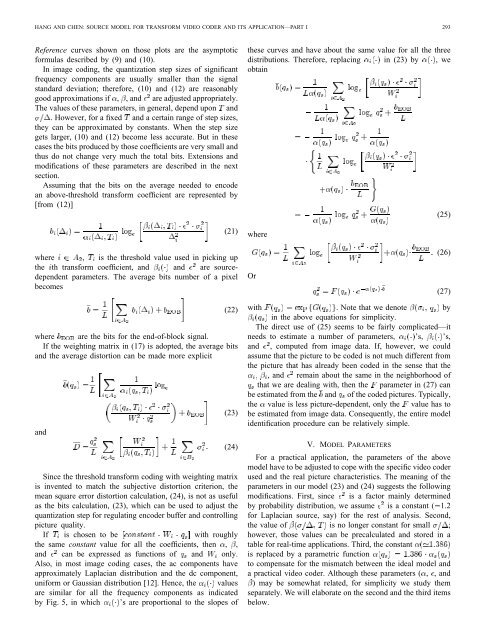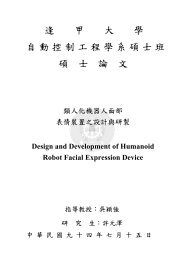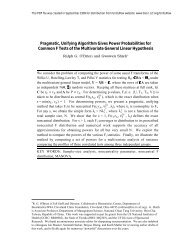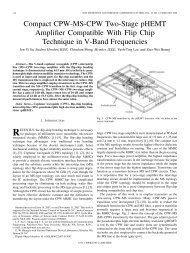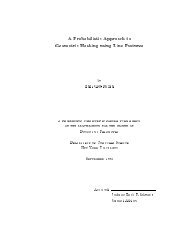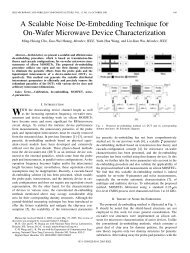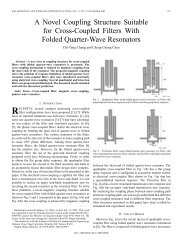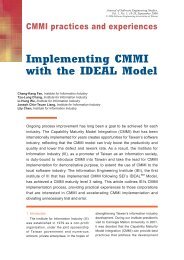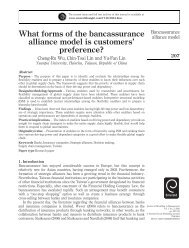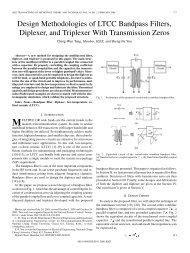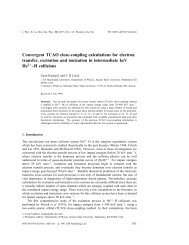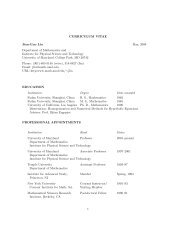Source Model for Transform Video Coder and its ... - ResearchGate
Source Model for Transform Video Coder and its ... - ResearchGate
Source Model for Transform Video Coder and its ... - ResearchGate
Create successful ePaper yourself
Turn your PDF publications into a flip-book with our unique Google optimized e-Paper software.
HANG AND CHEN: SOURCE MODEL FOR TRANSFORM VIDEO CODER AND ITS APPLICATION—PART I 293<br />
Reference curves shown on those plots are the asymptotic<br />
<strong>for</strong>mulas described by (9) <strong>and</strong> (10).<br />
In image coding, the quantization step sizes of significant<br />
frequency components are usually smaller than the signal<br />
st<strong>and</strong>ard deviation; there<strong>for</strong>e, (10) <strong>and</strong> (12) are reasonably<br />
good approximations if , , <strong>and</strong> are adjusted appropriately.<br />
The values of these parameters, in general, depend upon <strong>and</strong><br />
. However, <strong>for</strong> a fixed <strong>and</strong> a certain range of step sizes,<br />
they can be approximated by constants. When the step size<br />
gets larger, (10) <strong>and</strong> (12) become less accurate. But in these<br />
cases the b<strong>its</strong> produced by those coefficients are very small <strong>and</strong><br />
thus do not change very much the total b<strong>its</strong>. Extensions <strong>and</strong><br />
modifications of these parameters are described in the next<br />
section.<br />
Assuming that the b<strong>its</strong> on the average needed to encode<br />
an above-threshold trans<strong>for</strong>m coefficient are represented by<br />
[from (12)]<br />
(21)<br />
these curves <strong>and</strong> have about the same value <strong>for</strong> all the three<br />
distributions. There<strong>for</strong>e, replacing in (23) by ,we<br />
obtain<br />
where<br />
(25)<br />
where , is the threshold value used in picking up<br />
the th trans<strong>for</strong>m coefficient, <strong>and</strong> <strong>and</strong> are sourcedependent<br />
parameters. The average b<strong>its</strong> number of a pixel<br />
becomes<br />
Or<br />
(26)<br />
(27)<br />
(22)<br />
where are the b<strong>its</strong> <strong>for</strong> the end-of-block signal.<br />
If the weighting matrix in (17) is adopted, the average b<strong>its</strong><br />
<strong>and</strong> the average distortion can be made more explicit<br />
<strong>and</strong><br />
(23)<br />
(24)<br />
Since the threshold trans<strong>for</strong>m coding with weighting matrix<br />
is invented to match the subjective distortion criterion, the<br />
mean square error distortion calculation, (24), is not as useful<br />
as the b<strong>its</strong> calculation, (23), which can be used to adjust the<br />
quantization step <strong>for</strong> regulating encoder buffer <strong>and</strong> controlling<br />
picture quality.<br />
If is chosen to be with roughly<br />
the same constant value <strong>for</strong> all the coefficients, then , ,<br />
<strong>and</strong> can be expressed as functions of <strong>and</strong> only.<br />
Also, in most image coding cases, the ac components have<br />
approximately Laplacian distribution <strong>and</strong> the dc component,<br />
uni<strong>for</strong>m or Gaussian distribution [12]. Hence, the values<br />
are similar <strong>for</strong> all the frequency components as indicated<br />
by Fig. 5, in which ’s are proportional to the slopes of<br />
with . Note that we denote by<br />
in the above equations <strong>for</strong> simplicity.<br />
The direct use of (25) seems to be fairly complicated—it<br />
needs to estimate a number of parameters, ’s, ’s,<br />
<strong>and</strong> , computed from image data. If, however, we could<br />
assume that the picture to be coded is not much different from<br />
the picture that has already been coded in the sense that the<br />
, <strong>and</strong> remain about the same in the neighborhood of<br />
that we are dealing with, then the parameter in (27) can<br />
be estimated from the <strong>and</strong> of the coded pictures. Typically,<br />
the value is less picture-dependent, only the value has to<br />
be estimated from image data. Consequently, the entire model<br />
identification procedure can be relatively simple.<br />
V. MODEL PARAMETERS<br />
For a practical application, the parameters of the above<br />
model have to be adjusted to cope with the specific video coder<br />
used <strong>and</strong> the real picture characteristics. The meaning of the<br />
parameters in our model (23) <strong>and</strong> (24) suggests the following<br />
modifications. First, since is a factor mainly determined<br />
by probability distribution, we assume is a constant ( 1.2<br />
<strong>for</strong> Laplacian source, say) <strong>for</strong> the rest of analysis. Second,<br />
the value of is no longer constant <strong>for</strong> small ;<br />
however, those values can be precalculated <strong>and</strong> stored in a<br />
table <strong>for</strong> real-time applications. Third, the constant<br />
is replaced by a parametric function<br />
to compensate <strong>for</strong> the mismatch between the ideal model <strong>and</strong><br />
a practical video coder. Although these parameters ( , , <strong>and</strong><br />
) may be somewhat related, <strong>for</strong> simplicity we study them<br />
separately. We will elaborate on the second <strong>and</strong> the third items<br />
below.


